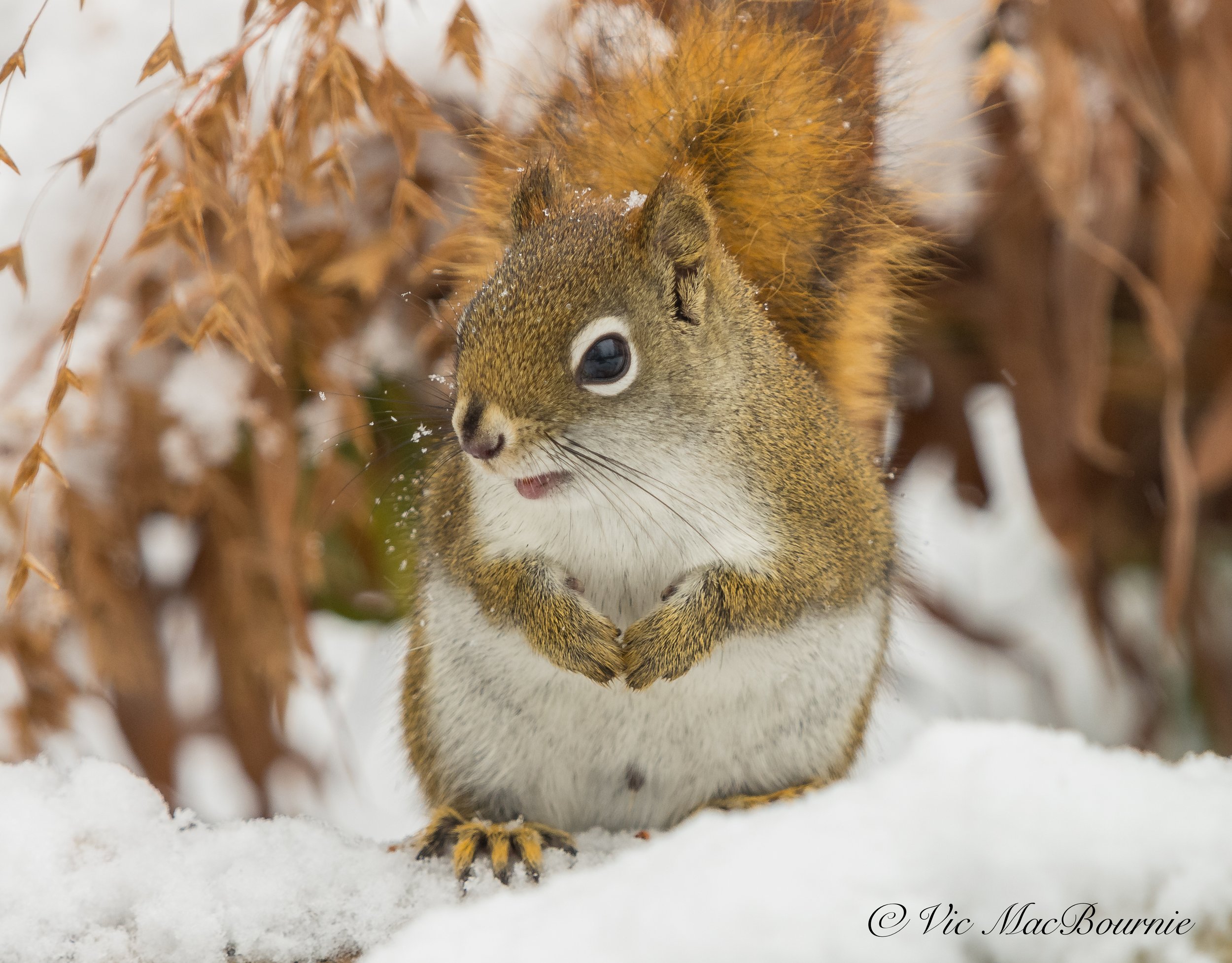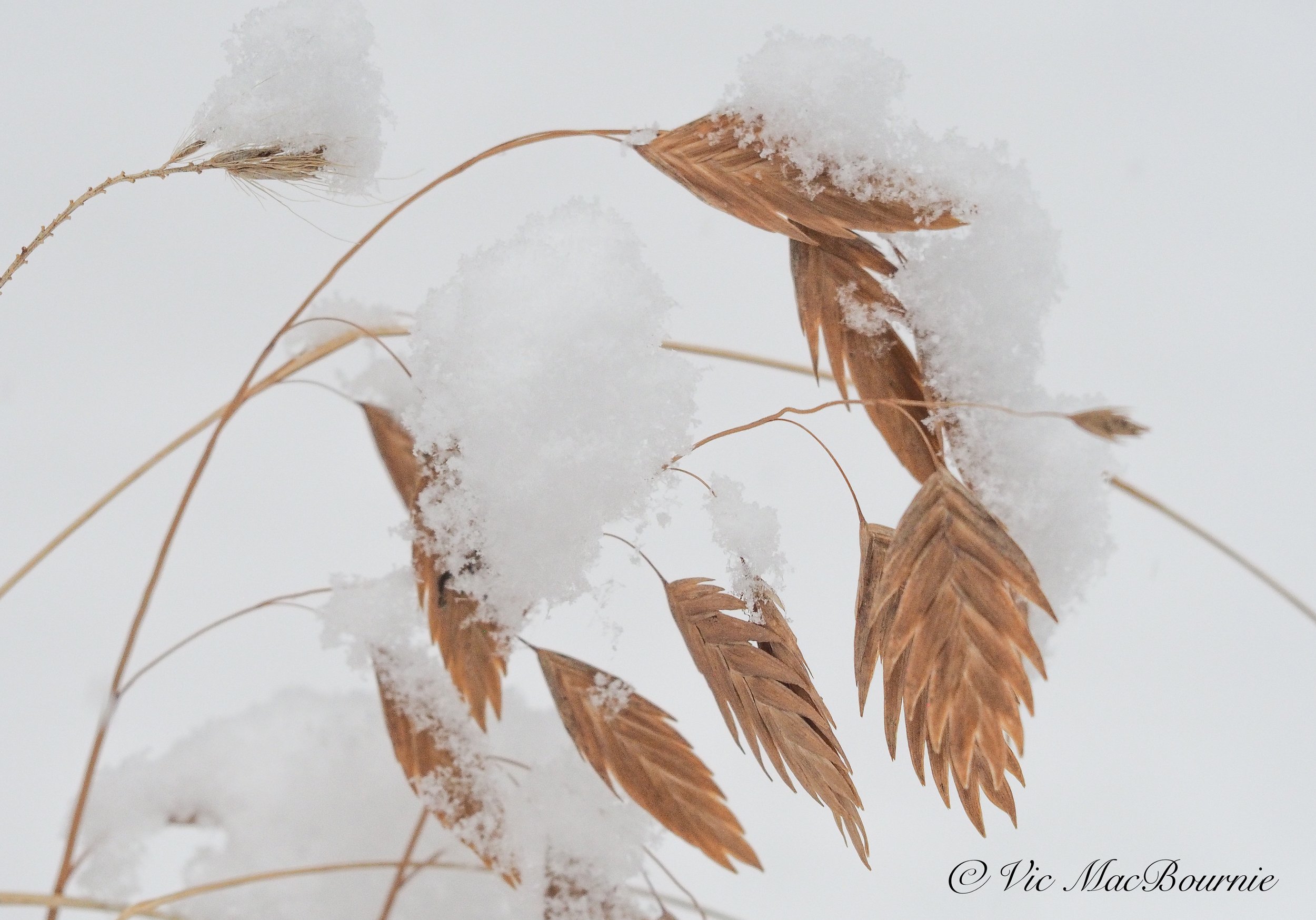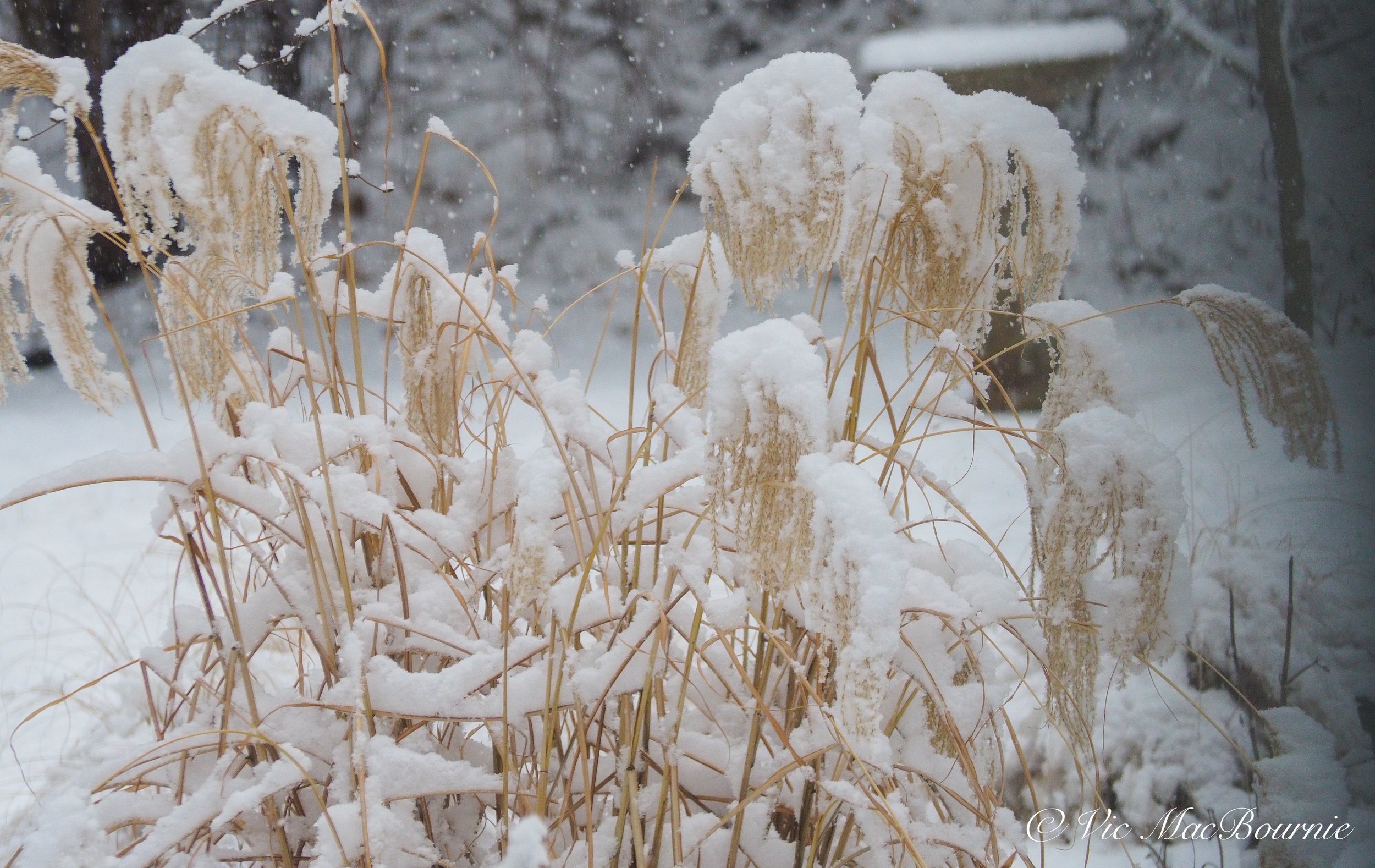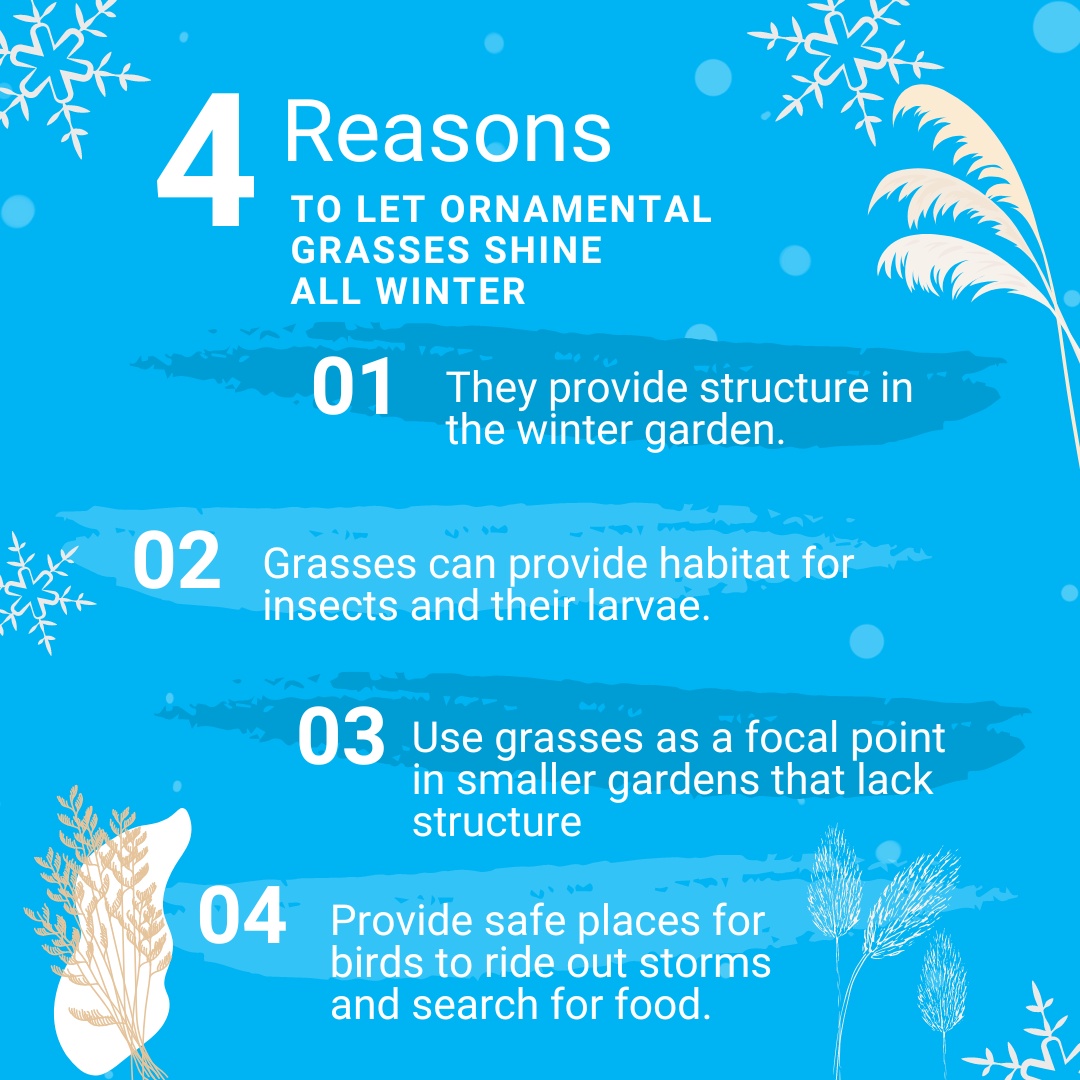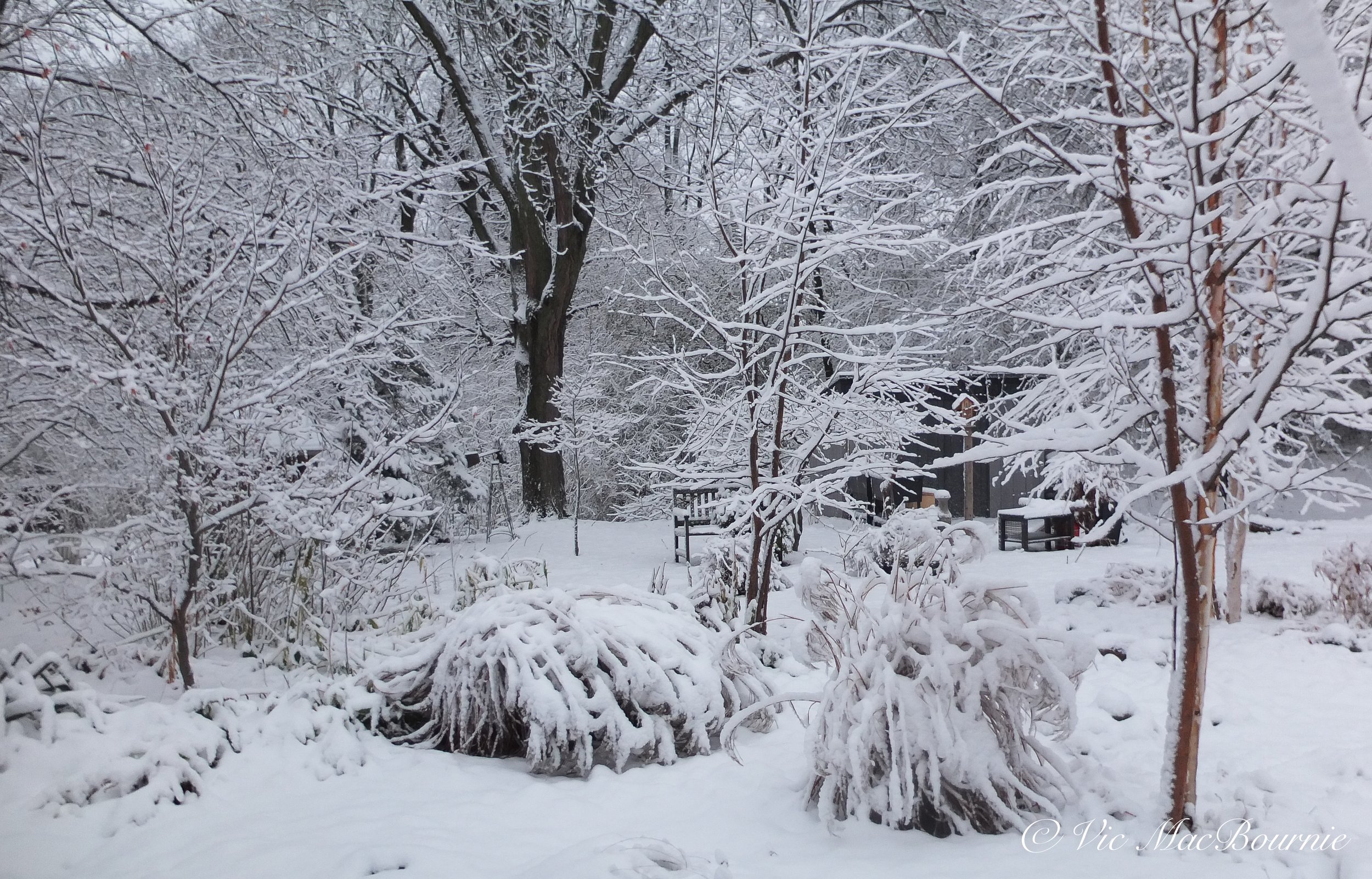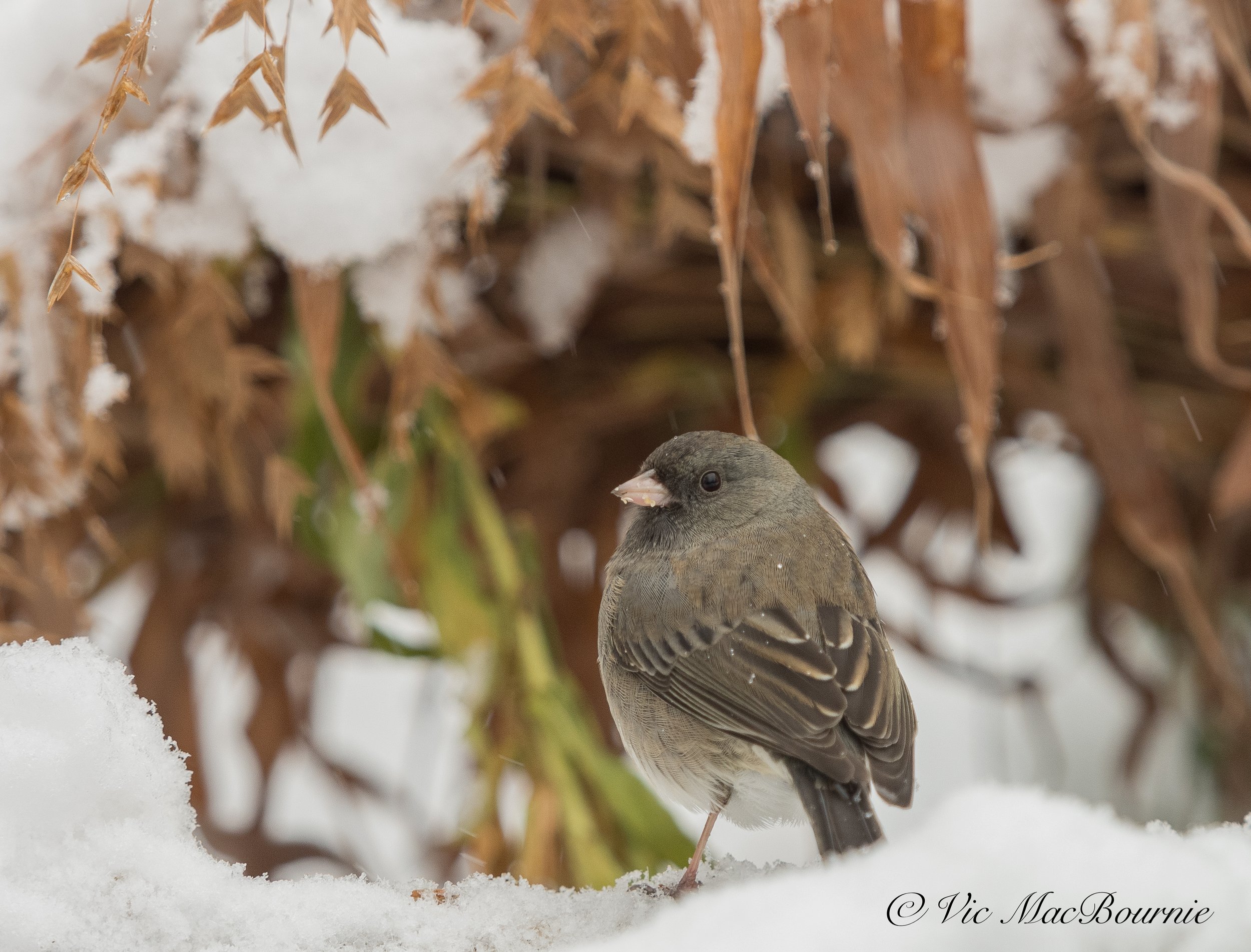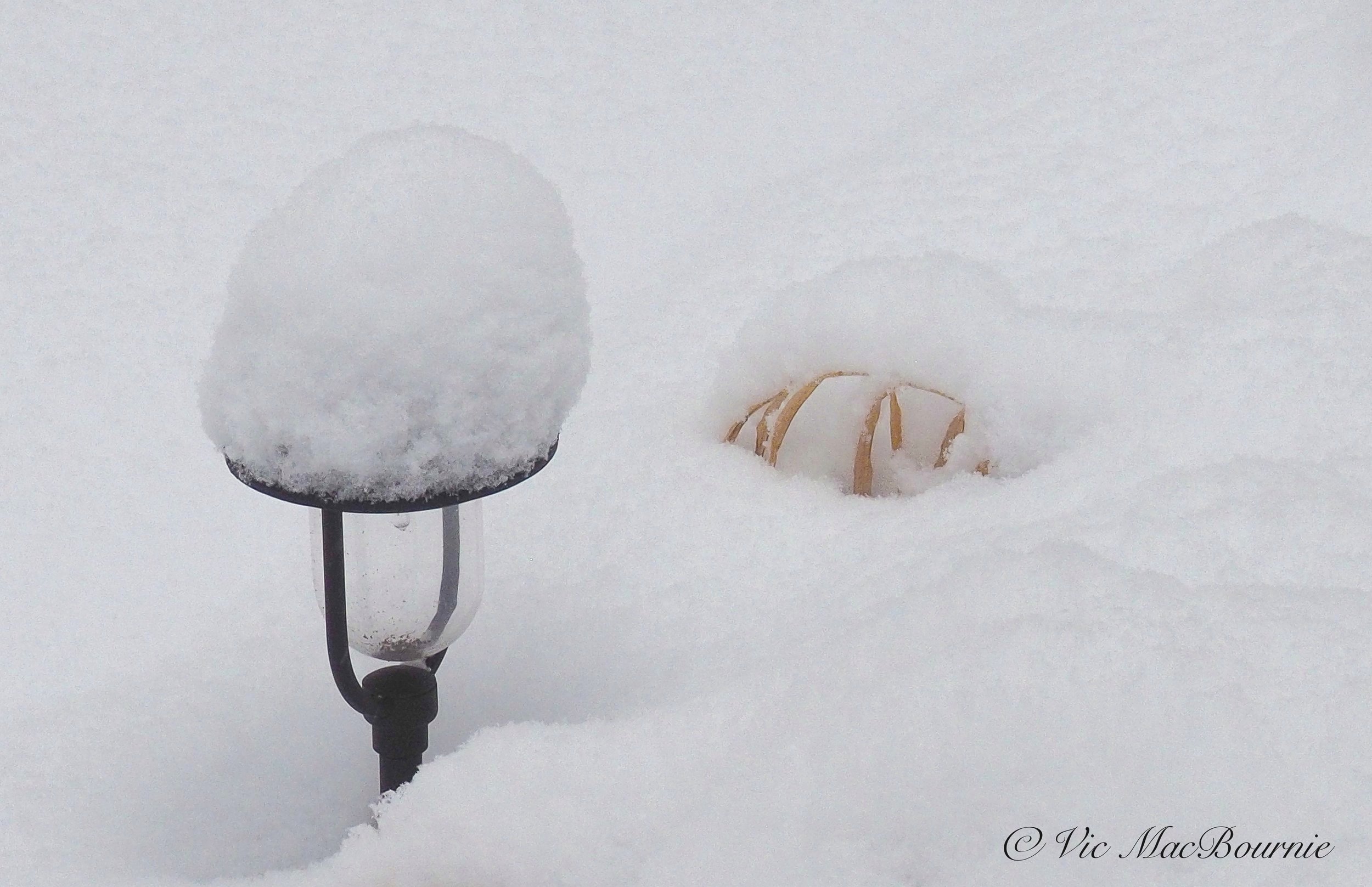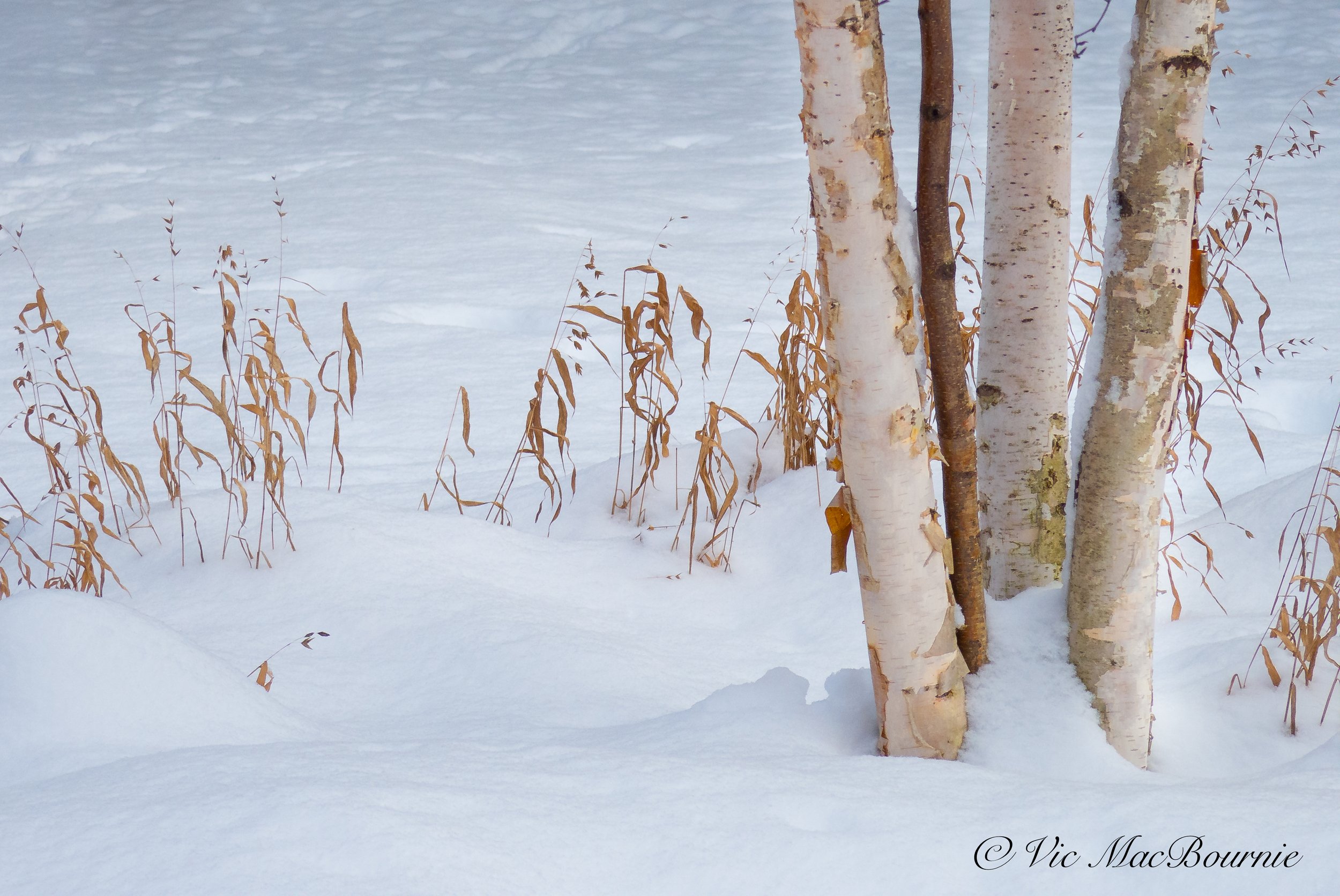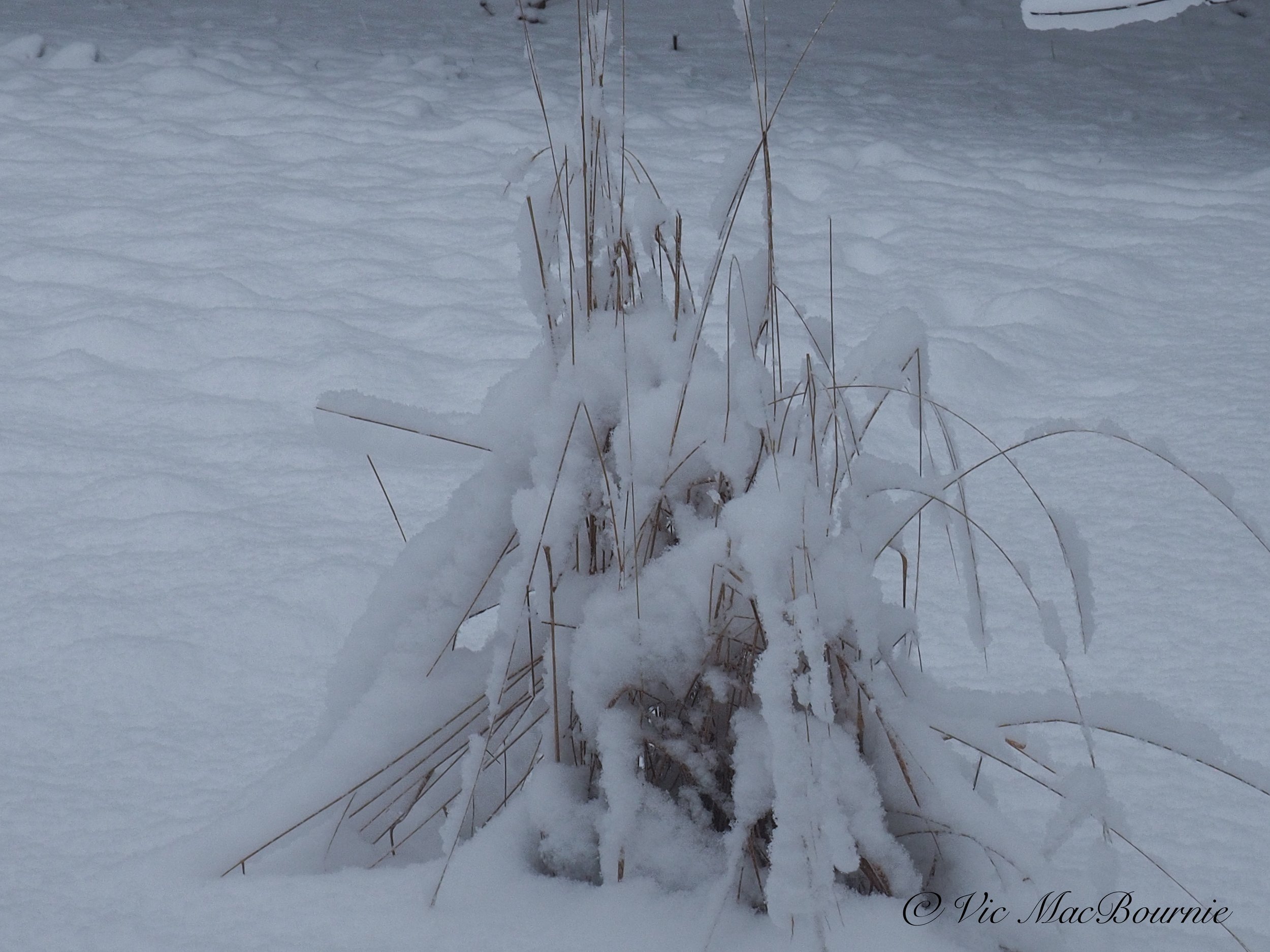Why leave ornamental grasses standing through winter?
Grasses provide structure and habitat for the garden in winter
There are two reasons I leave our grasses standing all winter. First, wildlife – from insects to birds – benefit from the standing grasses and second, I just love the look of the wheat-coloured grasses providing structure in the garden from the fall through to the following spring.
There is another important reason to leave the grasses standing, but we’ll get to that in a minute.
During the winter months, when snow is covering the ground, our grasses provide amazing structure to the garden and are often the first element I focus on when looking for photographic subjects. The results can range from high-key images of the delicate wisps of wheat-coloured grasses against a pure white background, to an image of a bird tucked away in the grasses waiting out a heavy snowfall.
In the early part of winter, capturing the seed heads poking out from the snow is a favourite subject, however, as winter draws on, the seeds heads are either eaten by the birds or dispersed from the cold winds.
Be sure to take advantage of the early part of winter to catch images of the seed heads in the snow.
It’s also a good time to capture the spent flower heads from the Black Eyed Susans with snow caps on before the goldfinches strip the seeds from the flower heads.
Are ornamental grasses perennial?
You may ask if ornamental grasses are annual or perennial? The answer is, of course, it depends. But it’s safe to say that most ornamental grasses you purchase are hardy perennials and will return year after year. Most ornamental grasses are very hardy but a few, including the large red- or purple-coloured fountain grass (Pennisetum setaceum) that is popular to use in containers, is a fast-growing – up to 4-feet – annual in most areas. It is actually hardy in tropical zone 9.
Because most ornamental grasses are perennial, they will require cutting down when they have expired. There is no problem leaving perennial or annual grasses up through the winter. Both will provide structure and beauty throughout the cold months.
Annual grasses, including the annual purple fountain grass, can simply be removed and discarded in the spring along with the cuttings of the perennial grasses.
I like to pile them on top of a natural compost heap to give the birds an opportunity to take the grass to build their nests. I also stuff handfulls of the dried grass in the suet holders in spring for the birds to take as nesting material.
More on Ornamental grasses:
Grasses help form the structure of a winter garden
Ornamental grasses might be the last thing you think of when looking for winter structure and interest in the garden. Typically, we look to evergreens to form the basic structure of a winter’s garden. Not everyone, however, has room to plant large evergreens such as spruce, pines or cedars.
That’s when ornamental grasses rise to the challenge.
Small enough to suit even the most compact gardens, these grasses can provide four-season interest with winter, arguably, being the time they shine the most. In many gardens, they are the only non-woody plant still standing, and their tan colour helps them stand out against a snowy or just drab winter background.
They can also add movement when the winds of winter blow, and their vase-like structure adds another dimension to our garden.
A third reason to leave your ornamental grasses
There is another very important reason to leave grasses standing throughout the winter, and that is to protect the roots of the grasses from extreme temperatures, especially the constant freezing and thawing that is common over the course of our winters.
If you are like me and fall garden clean up amounts to putting away the hummingbird feeders, patio umbrellas and garden chairs, then you’ll benefit from a buildup of leaves around the plants which will form a nice layer of insulation around the roots of the grasses. The grasses will often fold in on themselves as well, providing additional “winter mulch” for the plants, wildlife and insects that count on the grasses for protection and habitat.
This insulation layer will help keep the roots from experiencing the freeze-thaw cycles that can uproot some plants, especially if they are newly planted and the roots have not yet set in completely. Or, if you recently planted a clump after dividing a larger clump of your ornamental grasses in the fall.
This is also the area around the roots where insects will burrow in to survive the winter or lay eggs for next spring.
It’s not uncommon to see Juncos and other insect-eating birds foraging around the leaves at the roots of our grasses looking for insects and larvae.
Ornamental grasses can be a haven for birds in winter
The larger grasses that form sturdy upright branches can provide protection for birds in winter. I have seen birds go into the thick grasses during winter storms to escape the high winds and extreme cold. Some of the grasses get bent over and form a perfect perch for the birds.
Ornamental grasses would not be the first places the birds choose to ride out a winter storm, but if large evergreen trees are scarce in your neighbourhood, tall grasses would probably provide the next best natural shelter.
Best Ornamental grasses for winter interest
Some grasses are definitely better than others for winter interest. Some of the smaller grasses are covered early by snow and others are not vigorous enough to stand up to the harshness of our winters.
Look for native grasses whenever possible to provide the most benefits for wildlife and ensure you are not contributing to invasive non-native grasses spreading into natural areas.
The miscanthus grasses are particularly good for winter interest. They stand over six feet tall in summer with their feathery upright and very attractive pinkish seed heads. In winter, ours usually get knocked down to about four-feet high, allowing them to still stand above even the highest snow accumulations.
The stems turn a lovely beige-tan colour with the beautiful plumes lasting well into winter.
I also find our smaller fountain grasses to be excellent in the first half of the winter before the snow gets too high and buries the plants. But even a tiny bit of the grasses peaking up through the snow can result in a lovely, delicate photographic image. If you are searching for images, look for a single grass blade or grouping of three delicate beige grass blades forming an arc in the snow. If the seed head still remains, it’s a pure bonus.
The hybrid fountain grass Karly Rose is a larger fountain grass that carries lovely pink seed heads in late summer and can withstand more snow in winter before it is buried.
Panicum grasses are also a strong performer with great winter interest.
Calamagrotis Karl Foerster, a popular grass used in both commercial and residential landscaping is another grass that works well in the winter landscape. It’s upright habit and dense growth keeps it performing well into winter even in areas with high snowfall.
Photographing grasses in winter
Grasses, either covered in snow or mostly buried in winter’s ground cover, can be a rewarding photographic experience. But it’s usually not as simple as grabbing your camera and snapping a picture.
Successfully capturing the beauty of grasses in winter involves a number of factors that need to be considered.
The key to success is recognizing the amount of snow in the image. If you are photographing wisps of delicate grasses against a background of snow, it’s important to maintain the delicate look of the image. This would be an example of a high key image where the photograph has a clean white background with just a delicate hint of colour.
To create this image we want to “open up” our lens to allow more light into the scene.
What does this mean and how do you do it?
Shooting a snowy (or white sand beech) scene will trick the camera into thinking there is an incredible amount of light available. As a result, the camera will reduce the amount of light hitting the sensor (film) and give you snow that is very blue or, in the case of black and white photography, very grey. We’ve all seen the Instagram images of a lovely snow scene where the snow is blue and the real subject is too dark.
This is just the result of the camera doing what it does and using the metering system to create a “middle grey” image of the scene.
To compensate for this situation, and ensure the snow stays white, photographers say we have to “open up.” What they mean is we have to add back the light the camera wants to take away from the scene.
Today’s modern cameras are very good at recognizing various lighting conditions, but an abundance of snow is too much for most camera meters.
Below is an example of a typical underexposed snow scene. Compare it to the image below with the proper exposure.
An example of an underexposed snow scene where the snow turns grey or blue as opposed to holding its clean white look.
The same image shows a properly exposed scene where the white snow maintains its proper colour.
Escaping the blues: Simple solutions to photographing in the snow
The solutions to getting white snow are simple.
• If you are shooting in a program mode, (SP, AP or P mode) where the camera is automatically determining the proper exposure, try using the +1, +2 or even +3 compensation override to add the light back to the subject and make the snow white.
Be careful not to add too much compensation or you will (blow out) or take away the detail and texture in the snow. (If you are shooting a snow scene with a lot of blue sky, it’s unlikely any compensation would be necessary.)
• Possibly the easiest way to get the proper exposure is to go to the camera’s programmed shooting modes and look for the snow or sand/beach modes. Use these modes to photograph the snowy landscape. These modes automatically account for the brightness and make adjustments to keep the snow white. You may, however, have to use the camera’s compensation function (maybe +1) to tweak the scene depending how much snow is in the image.
In addition to the snow/sand modes, many of today’s compact cameras also include an “art mode” that allows the photographer to experiment with more artsy images. Set the camera to “high key” to create a delicate, ethereal look that might suit your image perfectly. This would work in a situation where you are moving in close on just a few strands of grass with a pure white background.
• Finally, if you are shooting in manual mode, get the camera’s suggested exposure and then use the +1, +2,+3 compensation to find an exposure that looks right. You can just check the back of the camera to get a feel for how the final image will look.
Bracket your snow scenes for best results
Getting properly exposed images in winter can be tricky, so it is probably a good idea to use bracketing whenever possible.
Bracketing is a process where you tell the camera to shoot a series of images at different settings – most often three images – where one image follows the camera’s suggested meter reading, another is a stop over and the final is a stop under. The result are three images where you have the opportunity to pick the one that works best for you.
I would suggest setting up the bracketing function before going outside so that you don’t have to fiddle with it in the cold.
Of course, some of these adjustments can be made in Lightroom or photoshop after you have taken the images, but it’s best to get it right in camera.
With a few simple adjustments to your approach, there is no reason to put the camera away during winter. Your garden takes on a completely different look in winter and its an opportunity to capture the delicate beauty of winter.
It’s also an opportunity to see the potential weaknesses in your garden’s structure. A picture never lies. Use your winter images to improve the garden structure come spring.
It’s just another good reason to buy more plants.
Use a camera with a viewfinder when shooting in the snow
It can be extremely difficult to see what you are photographing if you are using a camera without a viewfinder and being forced to use the camera’s LCD screen. If you are going out to shoot in the snow, either choose a camera with a built-in viewfinder or consider purchasing a separate viewfinder for the camera. The are usually a few you can choose from that would work with the camera.
There are also attachments available that can fit over the back of your camera to shade the LCD screen.

